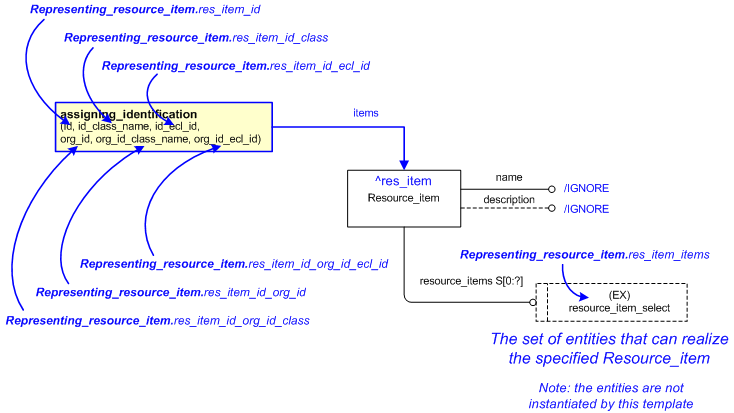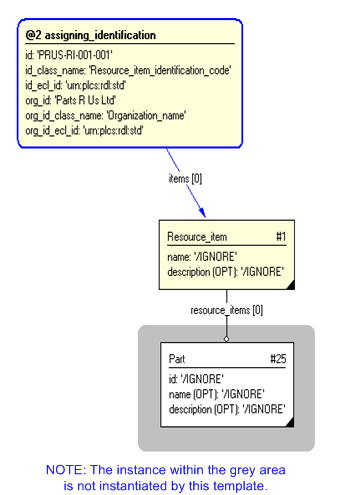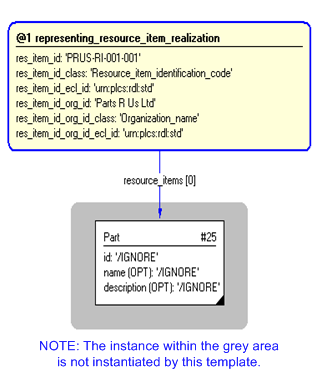Template:— representing_resource_item_realization (rep_res_item_real)
Capability:representing_resource
![[warning:]](../../../../images/dex/warning.gif) The use of this template is deprecated.
() The use of this template is deprecated.
()
|
Date: 2010/01/20 15:28:57
Revision: 1.10
|
This section specifies the template representing_resource_item_realization.
NOTE
The template has been defined in the context of the capability
representing_resource
which provides an overall description of the
relevant parts of the ISO 10303-239 information model and a description
of related templates.
NOTE
An explanation of a template and the associated instantiation path is
provided in the
Template overview
section.
This template describes how to represent the realization of a resource item, where the resource item is used as a placeholder
for the object that the resource item may refer to.
Note:
While this template continues to be maintained for backward compatibility, its use has deprecated and may be removed in the
future. The template representing_resource_item shall be used instead.
The EXPRESS-G diagram in
Figure
1
shows the templates and EXPRESS entities that are required
to represent the template
"representing_resource_item_realization".
The text highlighted in blue shows the template parameters.
Figure 1 — An EXPRESS-G representation of the Information model for representing_resource_item_realization
The graphic for the template to be used in other EXPRESS-G diagrams
is shown in Figure
2
below.
Figure 2 — The graphical representation of the representing_resource_item_realization template
The following input parameters are defined for this template:
The type of identifier (@res_item_id) being referenced
The following classes and their sub-classes can be used:
The following classes and their sub-classes can be used:
The id of the
External_class_library storing the
definition of the class used to classify the organization identifier.
Item that shall be added to the SET of resource items that realizes the resource item under consideration.
The following reference parameters are defined for this template:
Allow the
Resource_item
entity instantiated in this path to be referenced when this template is used.
Note: The
Resource_item
entity can be referenced in a template path by:
%^target = $representing_resource_item_realization.res_item%
where
target
is the parameter to which the
Resource_item
is bound.
The following parameter combinations specify a uniqueness constraint:
Unique constraint: Resource item
The instantiation path shown below specifies the entities that are to be
instantiated by the template.
A description of templates and the syntax for the instantiation path is
provided in the
Templates Help/Information section.
The following entities are instantiated with attributes as specified:
The instance diagram in Figure
3
shows an example of the EXPRESS entities and templates that are instantiated by the template:
/representing_resource_item_realization(res_item_id='PRUS-RI-001-001', res_item_id_class='Resource_item_identification_code', res_item_id_ecl_id='urn:plcs:rdl:std', res_item_id_org_id='Parts R Us Ltd', res_item_id_org_id_class='Organization_name', res_item_id_org_id_ecl_id='urn:plcs:rdl:std', res_item_items='#1')/
(an illustration of the consolidated representing_resource_item_realization template is shown in
Figure
4 below.)
Figure 3 — Entities and templates used by representing_resource_item_realization template
The instance model in STEP ASCII exchange file format (ISO 10303 Part
21 syntax) is:
#1 = RESOURCE_ITEM('/IGNORE','/IGNORE',(#25));
#3 = IDENTIFICATION_ASSIGNMENT('PRUS-RI-001-001','/IGNORE',$,(#1));
#5 = CLASSIFICATION_ASSIGNMENT(#7,(#3),'/IGNORE');
#7 = EXTERNAL_CLASS('/NULL','Resource_item_identification_code','/IGNORE',#8);
#8 = EXTERNAL_CLASS_LIBRARY('urn:plcs:rdl:std',$);
#10 = ORGANIZATION('/IGNORE','/IGNORE');
#12 = IDENTIFICATION_ASSIGNMENT('Parts R Us Ltd','/IGNORE','/IGNORE',(#10));
#14 = CLASSIFICATION_ASSIGNMENT(#16,(#12),'/IGNORE');
#16 = EXTERNAL_CLASS('/NULL','Organization_name','/IGNORE',#8);
#18 = ORGANIZATION_OR_PERSON_IN_ORGANIZATION_ASSIGNMENT(#10,'/IGNORE',(#3));
#20 = CLASSIFICATION_ASSIGNMENT(#22,(#18),'/IGNORE');
#22 = EXTERNAL_CLASS('/NULL','Owner_of','/IGNORE',#8);
#25 = PART('/IGNORE','/IGNORE','/IGNORE');
The instance diagram in
Figure
4
shows the graphic symbol for the template that is to be
used in other instance diagrams. The example template is:
/representing_resource_item_realization(res_item_id='PRUS-RI-001-001', res_item_id_class='Resource_item_identification_code', res_item_id_ecl_id='urn:plcs:rdl:std', res_item_id_org_id='Parts R Us Ltd', res_item_id_org_id_class='Organization_name', res_item_id_org_id_ecl_id='urn:plcs:rdl:std', res_item_items='#1')/
Figure 4 — Instantiation of representing_resource_item_realization template
Characterizations
No common characterizations of the template
representing_resource_item_realization
have been identified. However, the ISO 10303-239 EXPRESS model
may enable other assignments to the entities instantiated by the template.



